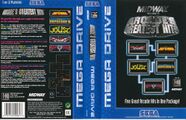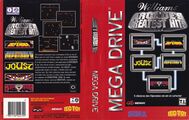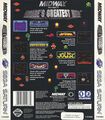Difference between revisions of "Williams Arcade's Greatest Hits (Mega Drive)"
From Sega Retro
m |
|||
| Line 32: | Line 32: | ||
==Gameplay== | ==Gameplay== | ||
| − | {{ | + | {{sectionsNewStart|imagewidths=200px}} |
| − | | | + | {{SectionsNew |
| − | | | + | | name=''Defender'' (1980) |
| − | | | + | | image=WAGH_Defender.png |
| − | | | + | | desc=''Defender'' is a 2D side-scrolling shoot-'em-up, in which the objective is to shoot aliens, avoid projectiles and obstacles and protect humans from being captured. It was unique for its day for allowing the player to move both left and right, the maps "looping" to create a "circular" playfield. It is also the primary influence for the [[Sega]] classic, ''[[Fantasy Zone]]''. |
Configurable options: ships to start, bonus at, difficulty increase, maximum difficulty, waves per planet. | Configurable options: ships to start, bonus at, difficulty increase, maximum difficulty, waves per planet. | ||
| − | + | }} | |
| − | | | + | {{SectionsNew |
| − | | | + | | name=''Defender II'' (''Stargate'') (1981) |
| − | | | + | | image=WAGH_DefenderII.png |
| + | | desc=''Defender II'' is the sequel to ''Defender'', though curiously was never known as ''Defender II'' in the arcades, instead opting for the title of ''Stargate'' on grounds of legal issues (''Defender II'' being reserved for the NES and older Atari 2600 ports). ''Defender II'' is much the same as the first game, but introduces new enemies, a cloaking device and similar minor gameplay additions. | ||
Configurable options: ships to start, bonus at, difficulty, inviso time per ship, men to warp, last wave for warp. | Configurable options: ships to start, bonus at, difficulty, inviso time per ship, men to warp, last wave for warp. | ||
| − | + | }} | |
| − | | | + | {{SectionsNew |
| − | | | + | | name=''Joust'' (1982) |
| − | | | + | | image=WAGH_Joust.png |
| + | | desc=''Joust'' is a single-screen 2D "platform game", in which players control a man riding a "buzzard", who needs to hit the heads of enemies, similar to traditional jousting. | ||
Configurable options: lives to start, bonus at, difficulty. | Configurable options: lives to start, bonus at, difficulty. | ||
| − | + | }} | |
| − | | | + | {{SectionsNew |
| − | | | + | | name=''Robotron 2084'' (1982) |
| − | | | + | | image=WAGH_Robotron2024.png |
| + | | desc=''Robotron 2084'' is a dual-joystick top-down shoot-'em-up, in which you attempt to save the last surviving human family from robots. This game traditionally causes problems on systems with less than four face buttons (like the Mega Drive), as without a means to emulate the dual joysticks, eight directional firing is hindered, making the game significantly harder. | ||
Configurable options: lives to start, bonus at, difficulty, controller angle. | Configurable options: lives to start, bonus at, difficulty, controller angle. | ||
| − | + | }} | |
| − | | | + | {{SectionsNew |
| − | | | + | | name=''Sinistar'' (1982) |
| − | | | + | | image=WAGH_Sinistar.png |
| + | | desc=''Sinistar'' is a top-down shooter similar to [[Atari]]'s ''Asteroids'', however as well as shooting enemies, players need to locate sinibombs to prevent the creation of the extremely powerful ''Sinistar''. | ||
Configurable options: ships to start, first bonus at, extra to next bonus, difficulty, rapid fire. | Configurable options: ships to start, first bonus at, extra to next bonus, difficulty, rapid fire. | ||
| − | |||
| − | |||
| − | |||
| − | |||
}} | }} | ||
| + | {{SectionsNew | ||
| + | | name=''Bubbles'' (1982) | ||
| + | | image= | ||
| + | | desc=''Bubbles'' is unique to the Saturn (and PlayStation) versions. Players control a bubble and need to clean a sink. ''Bubbles'' was less well received than the other games in this compilation back in 1982, so until this compilation emerged, did not see any home ports. | ||
| + | }} | ||
| + | |} | ||
==Production credits== | ==Production credits== | ||
| − | |||
===Mega Drive version=== | ===Mega Drive version=== | ||
| − | '''Lead Programmer and Game Translations (except Joust)''' | + | {{creditstable| |
| − | '''Joust Translation''' | + | {{creditsheader|}} |
| − | '''Sound Translation''' | + | *'''Lead Programmer and Game Translations (except Joust):''' Dan Filner |
| − | '''Producer''' | + | *'''Joust Translation:''' George Phillips |
| − | '''Special Thanks''' | + | *'''Sound Translation:''' Terry Coatta, Peter Phillips |
| + | *'''Producer:''' Andrew Ayre | ||
| + | *'''Special Thanks:''' Wes Gale | ||
| + | }} | ||
==Promotional material== | ==Promotional material== | ||
| Line 133: | Line 141: | ||
==References== | ==References== | ||
| − | <references /> | + | <references/> |
Revision as of 19:22, 25 June 2016
| Williams Arcade's Greatest Hits (Mega Drive) | |||||
|---|---|---|---|---|---|
| System(s): Sega Mega Drive, Sega Saturn | |||||
| Publisher: Williams Entertainment (US), THQ (EU) Midway | |||||
| Developer: Digital Eclipse | |||||
| Developer(s) of original games: Williams Electronics | |||||
| Game total: 6 | |||||
| Genre: Compilation | |||||
| Number of players: 1-2 | |||||
| |||||
Williams Arcade's Greatest Hits (Mega Drive) is a compilation of arcade games released in 1996/1997 for, among other systems, the Sega Mega Drive and Sega Saturn. The Mega Drive version was published by Williams Entertainment in North America, which, following restructuring and buyouts in the mid-1990s, became part of Midway Games, who published the European Mega Drive and Saturn versions as Midway Presents Arcade's Greatest Hits.
Arcade's Greatest Hits contains a selection of arcade games originally released by Williams Electronics in the early 1980s. The ports were handled by Digital Eclipse, who would go on to produce numerous re-releases of this nature (such as Midway Presents Arcade's Greatest Hits: The Atari Collection 1). Though the Saturn versions are nearly identical to their original arcade forms, on the Mega Drive slight alterations exist to accommodate the differing hardware. The Saturn version also has extras, such as videos and artwork.
The Sega Dreamcast game Midway's Greatest Arcade Hits Volume 1 is much the same as this release, although features higher quality emulations.
Contents
Gameplay
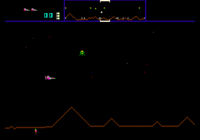
|
Defender (1980) |
|---|---|
| Defender is a 2D side-scrolling shoot-'em-up, in which the objective is to shoot aliens, avoid projectiles and obstacles and protect humans from being captured. It was unique for its day for allowing the player to move both left and right, the maps "looping" to create a "circular" playfield. It is also the primary influence for the Sega classic, Fantasy Zone.
Configurable options: ships to start, bonus at, difficulty increase, maximum difficulty, waves per planet. | |
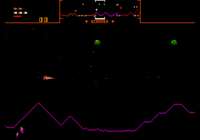
|
Defender II (Stargate) (1981) |
| Defender II is the sequel to Defender, though curiously was never known as Defender II in the arcades, instead opting for the title of Stargate on grounds of legal issues (Defender II being reserved for the NES and older Atari 2600 ports). Defender II is much the same as the first game, but introduces new enemies, a cloaking device and similar minor gameplay additions.
Configurable options: ships to start, bonus at, difficulty, inviso time per ship, men to warp, last wave for warp. | |
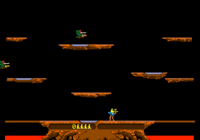
|
Joust (1982) |
| Joust is a single-screen 2D "platform game", in which players control a man riding a "buzzard", who needs to hit the heads of enemies, similar to traditional jousting.
Configurable options: lives to start, bonus at, difficulty. | |

|
Robotron 2084 (1982) |
| Robotron 2084 is a dual-joystick top-down shoot-'em-up, in which you attempt to save the last surviving human family from robots. This game traditionally causes problems on systems with less than four face buttons (like the Mega Drive), as without a means to emulate the dual joysticks, eight directional firing is hindered, making the game significantly harder.
Configurable options: lives to start, bonus at, difficulty, controller angle. | |
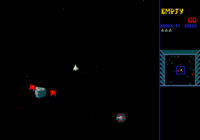
|
Sinistar (1982) |
| Sinistar is a top-down shooter similar to Atari's Asteroids, however as well as shooting enemies, players need to locate sinibombs to prevent the creation of the extremely powerful Sinistar.
Configurable options: ships to start, first bonus at, extra to next bonus, difficulty, rapid fire. | |
| Bubbles (1982) | |
| Bubbles is unique to the Saturn (and PlayStation) versions. Players control a bubble and need to clean a sink. Bubbles was less well received than the other games in this compilation back in 1982, so until this compilation emerged, did not see any home ports. |
Production credits
Mega Drive version
- Lead Programmer and Game Translations (except Joust): Dan Filner
- Joust Translation: George Phillips
- Sound Translation: Terry Coatta, Peter Phillips
- Producer: Andrew Ayre
- Special Thanks: Wes Gale
Promotional material
- ArcadesGreatestHits MD US PrintAdvert.jpg
Mega Drive US print advert
- ArcadesGreatestHits MD US PrintAdvert 2.jpg
Mega Drive US print advert 2
- ArcadesGreatestHits MD UK PrintAdvert.jpg
Mega Drive UK print advert
Physical scans
Mega Drive version
| Sega Retro Average | ||||||||||||||||||||||||||||||||||
|---|---|---|---|---|---|---|---|---|---|---|---|---|---|---|---|---|---|---|---|---|---|---|---|---|---|---|---|---|---|---|---|---|---|---|
|
| 64 | |
|---|---|
| Based on 6 reviews | |
Saturn version
| Sega Retro Average | ||||
|---|---|---|---|---|
|
| N/A | |
|---|---|
| Based on 0 reviews | |
References
- ↑ 1.0 1.1 File:MeanMachinesSega51UK.pdf, page 76 Cite error: Invalid
<ref>tag; name ":File:MeanMachinesSega51UK.pdf_p76" defined multiple times with different content - ↑ 1700 igr dlya Sega, "" (RU; 2001-xx-xx), page 263
- ↑ Electronic Gaming Monthly, "December 1996" (US; 1996-xx-xx), page 96
- ↑ GamePro, "February 1997" (US; 1997-xx-xx), page 89
- ↑ Sega Power, "January 1997" (UK; 1996-12-19), page 37
- ↑ Tricks 16 bit, "Tricks Sega Gold 800 igr" (RU; 1998-03-20), page 222
- ↑ File:SSM_UK_23.pdf, page 72
- Pages with broken file links
- Pages with reference errors
- 1-2 player games
- Old content rating field
- Use romtable template
- All games
- Credits without source
- Credits without reference
- Creditstable with no console field
- Old-style rating (mms)
- Use magref
- Old-style rating (segapower)
- Update ratings template
- 1 old ratings
- Old-style rating (gamesmaster)
- Rating without PDF source
- Old-style rating (ssm)
- 2 old ratings
- No ratings



